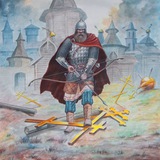Forwarded from Pagan Revivalism
Outside of the first modern Hellenic temple, constructed outside Arcadia, the judeo-christians destroyed a wooden statue dedicated to Pan, leaving their calling cards to claim responsibility.
Let this be a reminder to us who follow ancestral faiths, the judeo-christians are not your friends. They never were, never are and never will be.
We should be aware of such things and condemn it thusly. But there is also hope in knowing that they may damage a statue, but they cannot hurt our Gods and Goddesses. The Revival of Paganism is happening over ten times the rate as the early church spread. As the years go by we gain more legal recognition. It is only a matter of time before we overtake them. When that nears, they will beg to be accepted by us. When that does happen we should remember things like this, because it is actions such as this that is their true nature.
Pagan Revivalism is inevitable, and there is nothing, not a single thing, they can say or do to stop it.
Let this be a reminder to us who follow ancestral faiths, the judeo-christians are not your friends. They never were, never are and never will be.
We should be aware of such things and condemn it thusly. But there is also hope in knowing that they may damage a statue, but they cannot hurt our Gods and Goddesses. The Revival of Paganism is happening over ten times the rate as the early church spread. As the years go by we gain more legal recognition. It is only a matter of time before we overtake them. When that nears, they will beg to be accepted by us. When that does happen we should remember things like this, because it is actions such as this that is their true nature.
Pagan Revivalism is inevitable, and there is nothing, not a single thing, they can say or do to stop it.
🔥39❤3✍2
Forwarded from Dragonchaser's Voice
The christian society has built cages, prisons, in the sad attempt to make criminals repent for their "sins" through isolation and ostracization. Not even forced work to pay for their stay in prison solves the problem.
Criminals will rarely regret their life choices and recidivism becomes a constant factor in the justice system.
What did we, as pagans, had back then?
You either pay a massive fine, exiled for life, or executed by many ways (drowned, the blood eagle, decapitated).
This is how we punish crimes, this is how we make society safer: we punish, we break the bandit's will and show that crime does not pay you with anything good down the line.
Criminals will rarely regret their life choices and recidivism becomes a constant factor in the justice system.
What did we, as pagans, had back then?
You either pay a massive fine, exiled for life, or executed by many ways (drowned, the blood eagle, decapitated).
This is how we punish crimes, this is how we make society safer: we punish, we break the bandit's will and show that crime does not pay you with anything good down the line.
🔥29⚡8
Cetus
Cetus is not a singular creature, but a type of sea monsters in Greek myth. Ceti (plural form of Cetus) were slain by such heroes as Hercules and Perseus. The name of the constellation Cetus comes from these monsters as well as Cetology a science that studies whales, dolphins, and porpoises.
Cetus is not a singular creature, but a type of sea monsters in Greek myth. Ceti (plural form of Cetus) were slain by such heroes as Hercules and Perseus. The name of the constellation Cetus comes from these monsters as well as Cetology a science that studies whales, dolphins, and porpoises.
🔥15❤7
This media is not supported in your browser
VIEW IN TELEGRAM
The Kukeri of Ivaylovgrad from Bulgaria
⚡34🔥10❤4👍2
Forwarded from Snickerdoodle
This media is not supported in your browser
VIEW IN TELEGRAM
New-Age is a hubristic fraud.
She is no Druid: their lineage ended. Her "priestessship" is bogus. LGBTQ ideology is antithetical to traditional religions. Sumer, Egypt, Persia, Rome, and elsewhere would have exiled or killed her.
Stuff like this is why we get mocked.
She is no Druid: their lineage ended. Her "priestessship" is bogus. LGBTQ ideology is antithetical to traditional religions. Sumer, Egypt, Persia, Rome, and elsewhere would have exiled or killed her.
Stuff like this is why we get mocked.
⚡19🔥6👍5
Forwarded from Volkish Aryan Pagan
Knattleikr was an ancient ball game played by the Vikings. There is also a modern version of it created by dedicated re-enactors.
🔥15❤1
Lovely Terpsichore, one of the Muses, had borne them [Sirens] to Achelous, and at one time they had been handmaids to Demeter's gallant Daughter [Persephone], before she was married, and sung to her in chorus. But now, half human and half bird in form, they spent their time watching for ships from a height that overlooked their excellent harbour; and many a traveller, reduced by them to skin and bones, had forfeited the happiness of reaching home.
Apollonius Rhodius
Argonautica
Art: Sirens by V.Lapovok
Apollonius Rhodius
Argonautica
Art: Sirens by V.Lapovok
⚡9🔥6
Forwarded from Black Hills Heathenry
Media is too big
VIEW IN TELEGRAM
Thank you to Æsiric Media for making this video, and to all who helped by sending in testimonials.
When we work together we can accomplish great things.
Hail the gods
Hail the folk!
https://www.group-telegram.com/Aesiric
When we work together we can accomplish great things.
Hail the gods
Hail the folk!
https://www.group-telegram.com/Aesiric
👍11🔥4
